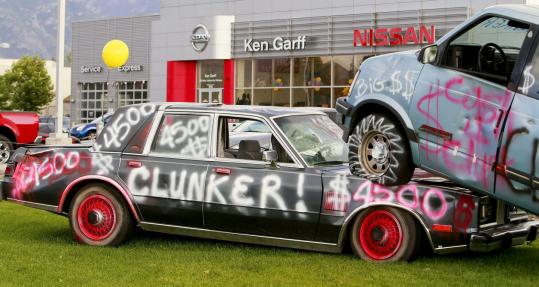I won’t hesitate to express my venom over the Car Allowance Rebate System. For the duration of the program, you had dealerships everywhere proudly proclaiming that what was a very capable vehicle when it was traded in was a “clunker”, usually spray-painted on the doors or marked on the glass as if it was the f**king Scarlet Letter. About this time, I was getting out of the Army, had cash in hand, and wasn’t too hot on buying new after an incident involving a Dodge dealership. Used car lots were my havens, but during the C4C program’s run dates, vehicles that I would’ve looked at were parked up in piles. Videos of cars like C4 Corvettes and pickup trucks that had absolutely nothing wrong with them being killed using the sodium silicate solution were flooding into YouTube boiled my blood, and when the list of vehicles that went into the program came out, “pissed off” couldn’t have even covered half of what was the truth.
The most popular vehicle traded in was a Ford Explorer, but vehicles like the known GMC Typhoon, various Mustangs and Camaros, Toyota Supras, and other cars in the THOUSANDS were sent to their final fate prematurely. Hundreds of thousands of vehicles…engines and transmissions, destroyed. Chassis, destroyed. And why? A few thousand bucks to spend on a vehicle that was supposed to be more fuel efficient than the car that some mouth-breather traded in for the program. The Roman from Regular Car Review takes a look at the program, from the origin of the program to the results and effects that have echoed since the program stopped.



























Thank you!!!! I knew, I wasn’t alone!!!!
I paid $53 (that’s FIFTY-THREE) for my ’89 Econoline, and got $4,500 for it 8 years later. It was knocking and completely rotted out.
I don’t see a booming market for these now, nor was anyone banging down my door to get mine then. So…. I guess I’m a mouth-breathing loser for taking that gem out of circulation.
It probably worked well on some occasions, like Brendan’s. A lot of nice cars must have been lost.
Did they destroy the VIN and let some parts loose or were they total loss? We didn’t have that program in Canada, but the road salt done as much damage.
The Ford Explorers were no great loss
In a nutshell, the biggest problem with C4C was that it took thousands of perfectly good cars off the road, while inflating the value of both serviceable and non-serviceable cars with sub-$4500 market values.
Perfectly good $2500 cars, were suddenly worth $4500. So were less perfectly good $500 cars. Tens of thousands of people who were ready to Craigslist out their high-mile minivan at $1500, for a brand new SUV, were more than happy to apply an extra and artificial $3k to the deal. Meanwhile, the family that’s a couple rungs down, that had a real need for that $1500 minivan were left holding the bag. They got C4C’d into laying out $4500 for a different $1500 minivan.
Rinse and repeat, in hundreds of thousands of similar combos, ad infinitum. Like most schemes cooked up by elites, it had no measurable impact on one of the goals- air quality, varyingly negative impacts on a vast group who not been factored into the equation- the low-income workforce, and an unfair but modest improvement in the economic fortunes of people who were going to buy a new car regardless of C4C.
And people wonder why I’m a hard core advocate of shrinking government. Radically and ruthlessly.
Sums up my thoughts exactly. What really pissed me off is that the yards weren’t supposed to sell parts off them either. Luckily I was able to work a deal with my local yard at the time for B Body parts that came in.
Taxpayers got hosed. The government spent over $8000 per rig for that $4500 subsidy. Anyone that took it is a thief.